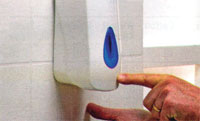



.jpg) GEOLOGY
GEOLOGY
Dripstone’s mountain tale
Mountain landscapes are the result of a constant interplay between erosion by climatic forces and uplift due to tectonic forces. Quantifying the rates of erosion and uplift is challenging. Scientists recently studied an ancient cave near the summits of the Allgau mountains in Aust ria. It has the oldest—radiometrically dated dripstone, two million years old. Using isotopic modelling, they studied its geochemical signature and biochemical inclusions, and were able to back-calculate depth of the cave and altitude of the summit at the time the dripstone was formed. Two million years ago the cave was 1,500 m lower and the summit was 500 m lower.
Smaller uplift of the mountain can be attributed to gra dual glacial erosion, the study suggests. Geology, May
.jpg) OCEAN SCIENCES
OCEAN SCIENCES
Small fries at greater risk
Shark, tuna and other top predators in the ocean have suffered major population drop in recent years, causing scientists to consider them as species at the highest risk of extinction. A study found smaller fishes like sardines are at a greater risk, and also require conservation measures.
In the past 60 years, their stocks have declined twice as much as that of the top predators due to overfishing, the scientists said after analysing 200 assessments of fisheries in the developed world. Since they are at the base of food chain and there are relatively few species at that level, a plunge in their population can hit both the oceanic and land food chains. PNAS, May 2
.jpg) ASTROPHYSICS
ASTROPHYSICS
Hot Jupiter puzzle solved
The sun and its planets spin in the same direction. This is not true for extrasolar systems. Using computer model, scientists have explained why. Opposite spin is usually exhibited by planets that are huge, called hot jupiters, and very close to the star. In the beginning, the giant planets lie close to each other but away from the sun, each orbiting in the same direction. A combination of forces— gravitational coupling among planets and powerful tides on the innermost planet—breaks up this symmetry.
Eventually, the inner planet starts orbiting in a needleshaped elongated path, which gradually shrinks. The planet is hauled in close to the star, creating the hot jupiter, and in the process its orbit can flip. Nature, May 12
.jpg) HEALTH
HEALTH
Wean them from the bottle
Babies who are bottle-fed until the age of two are likely to be obese by the time they turn five. Researchers analysed data on 6,750 children in the US and found 22 per cent of them used bottles regularly until two years, meaning they mainly drank from a bottle or were put to bed with one.
Many parents tend to prolong bottle-feeding because they say it pacifies and comforts the child. But this makes babies consume too many calories; a 200 ml bottle with whole milk has 150 calories, 12 per cent of most baby’s daily needs. When compared with kids who stopped using bottle by 12 months, regular users were 33 per cent more likely to be obese. The Journal of Pediatrics, May 5
PHYSICS
A polymer that heals on its own
Nobody likes scratches in their cars’ finish. Scientists have discovered a way to make a polymer that heals itself in the presence of UV light. This could revolutionise coatings and say good bye to scratches. The polymer is called metallosupramolecular, meaning it has metal atoms in it. Usually polymers are combinations of carbon, hydrogen and oxygen.
.jpg) |
.jpg) EVOLUTION
EVOLUTION.jpg) AGRICULTURE
AGRICULTURE HEALTH
HEALTH
.jpg)
We are a voice to you; you have been a support to us. Together we build journalism that is independent, credible and fearless. You can further help us by making a donation. This will mean a lot for our ability to bring you news, perspectives and analysis from the ground so that we can make change together.

Comments are moderated and will be published only after the site moderator’s approval. Please use a genuine email ID and provide your name. Selected comments may also be used in the ‘Letters’ section of the Down To Earth print edition.